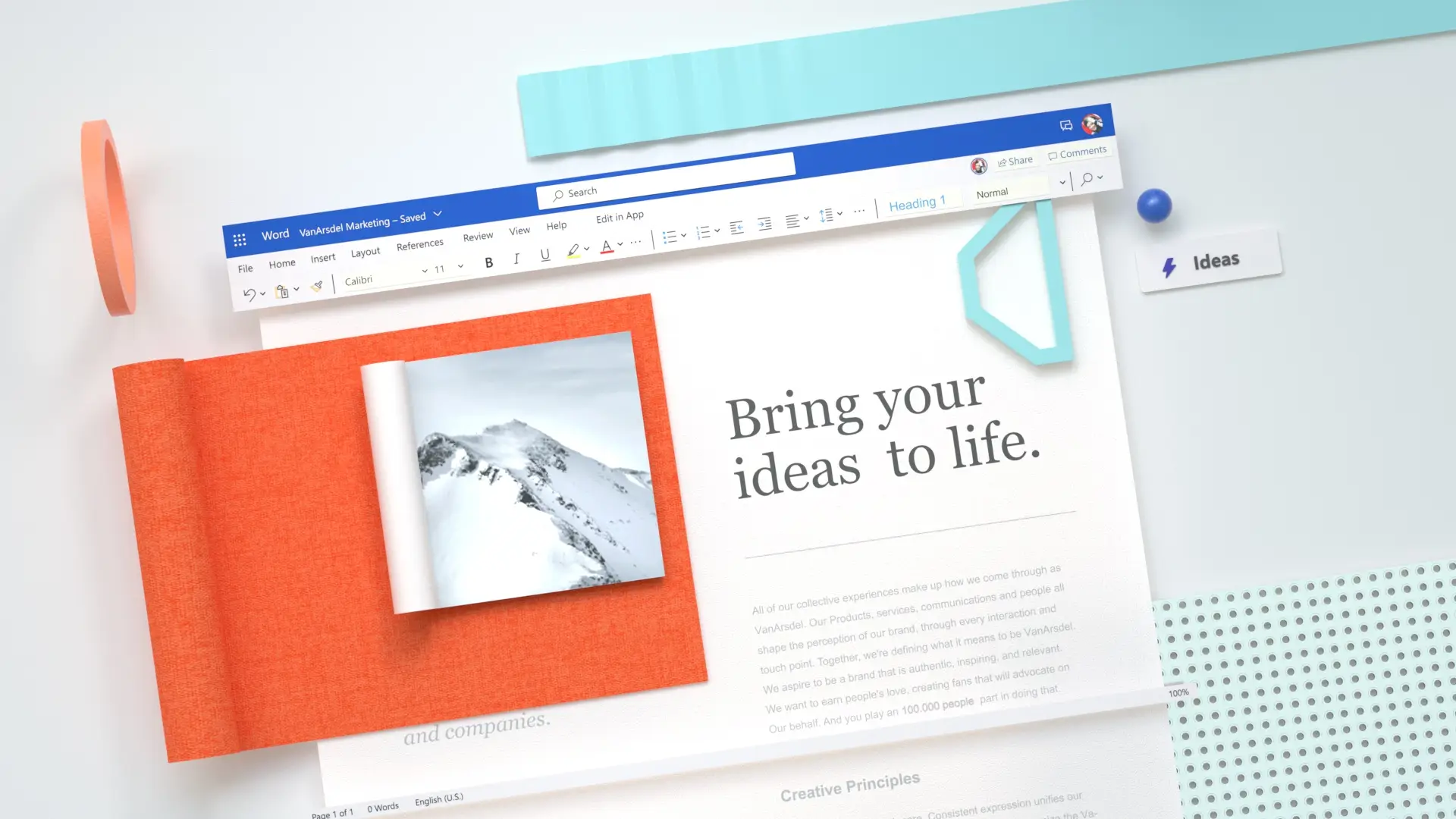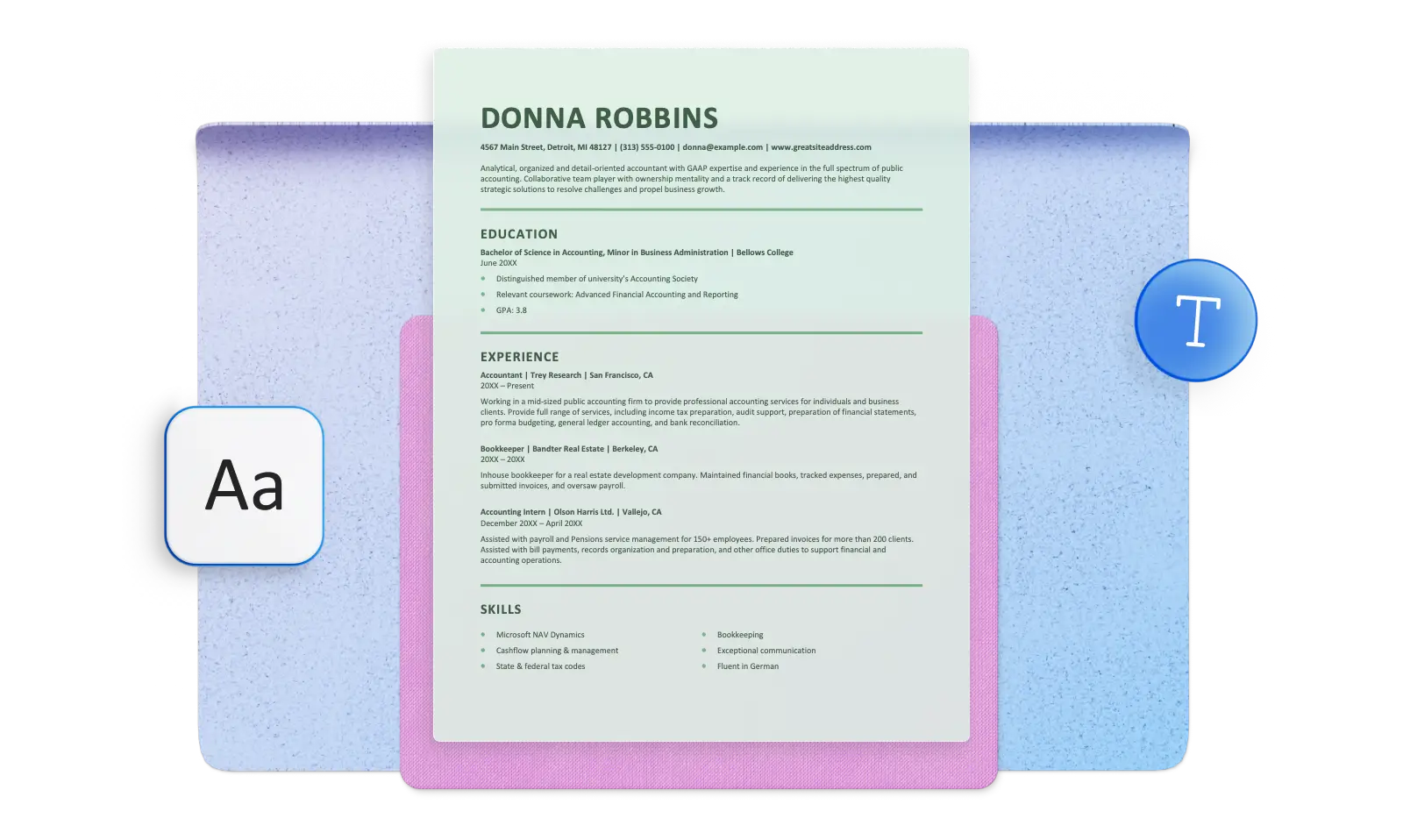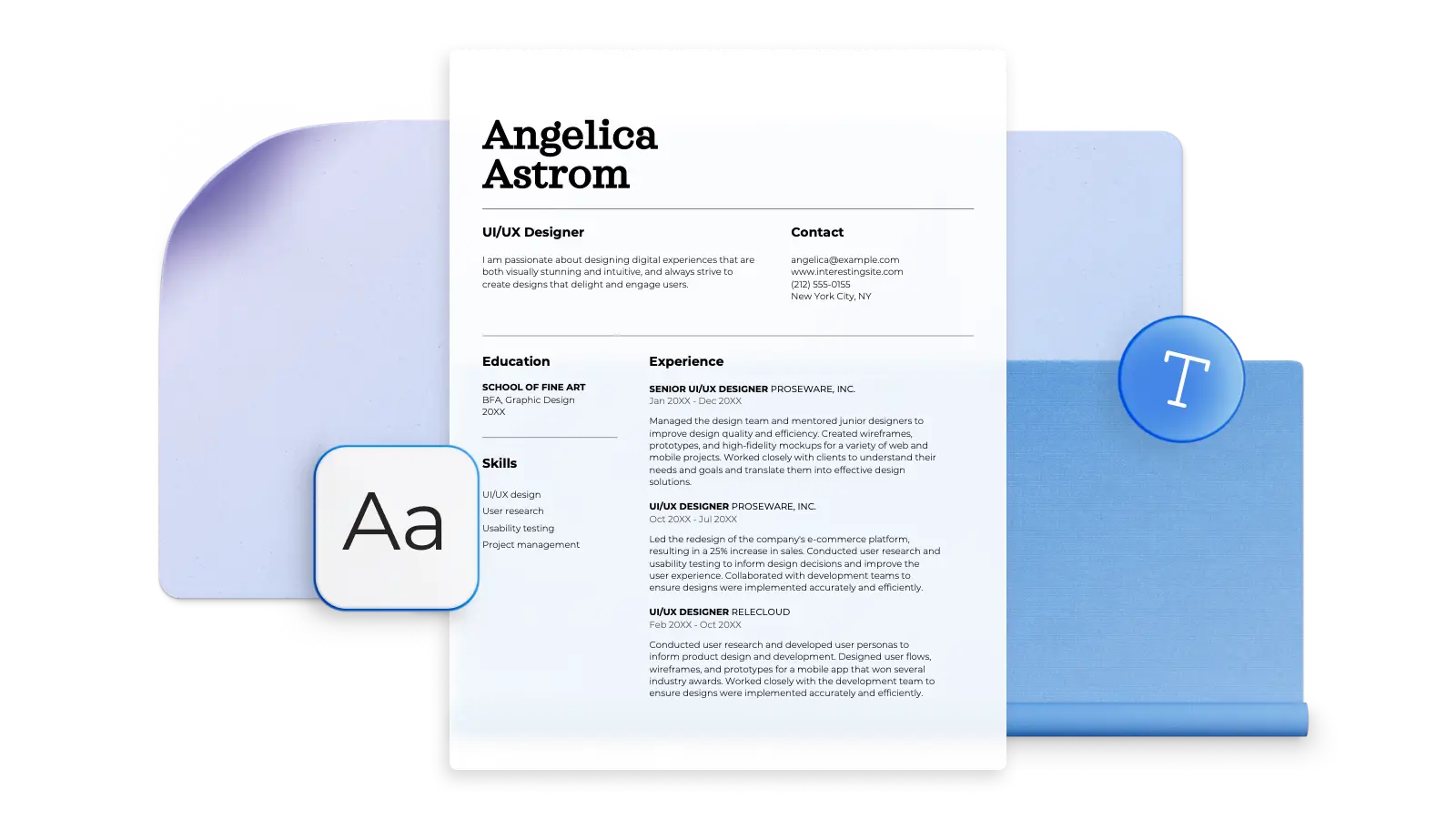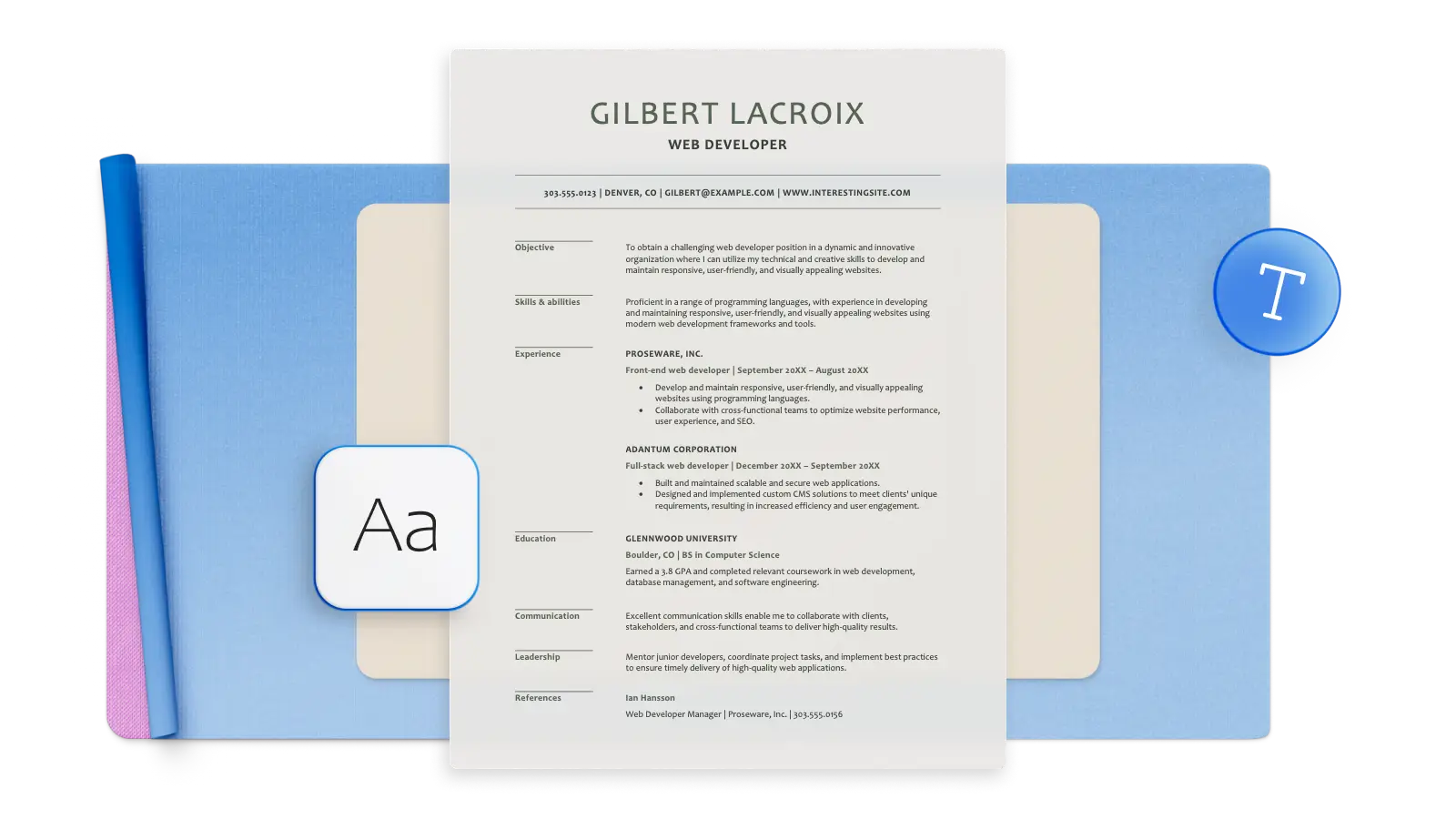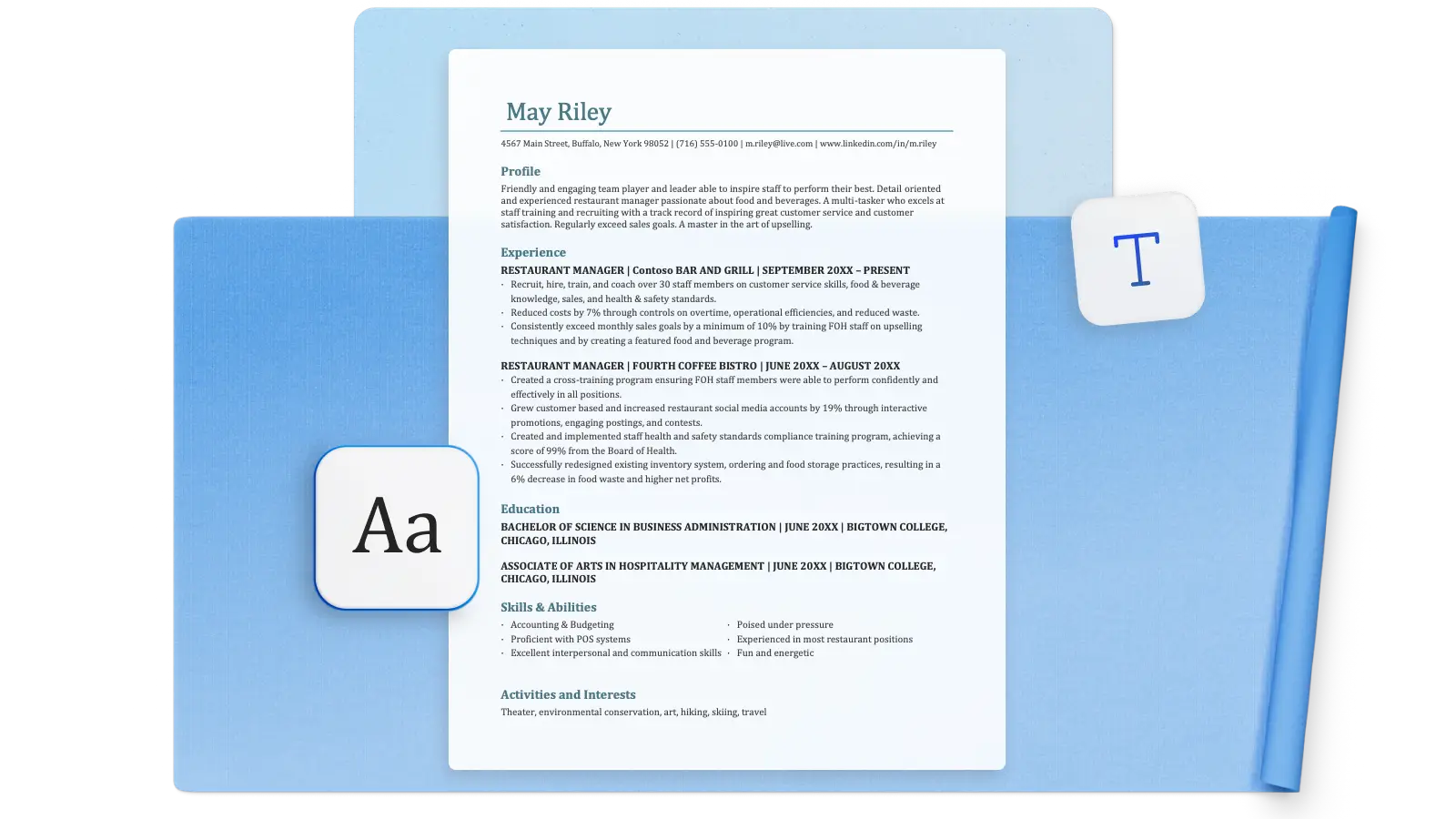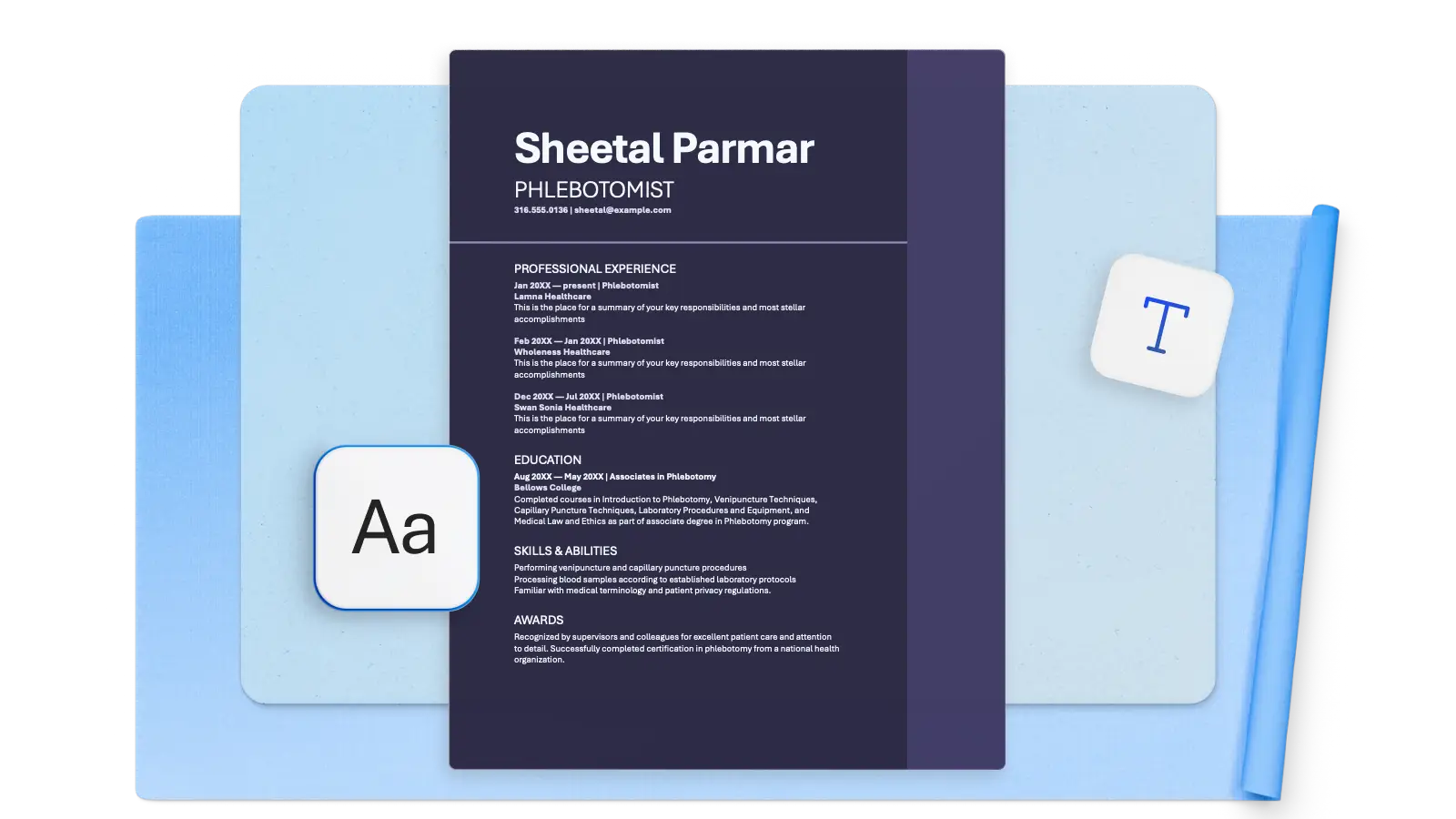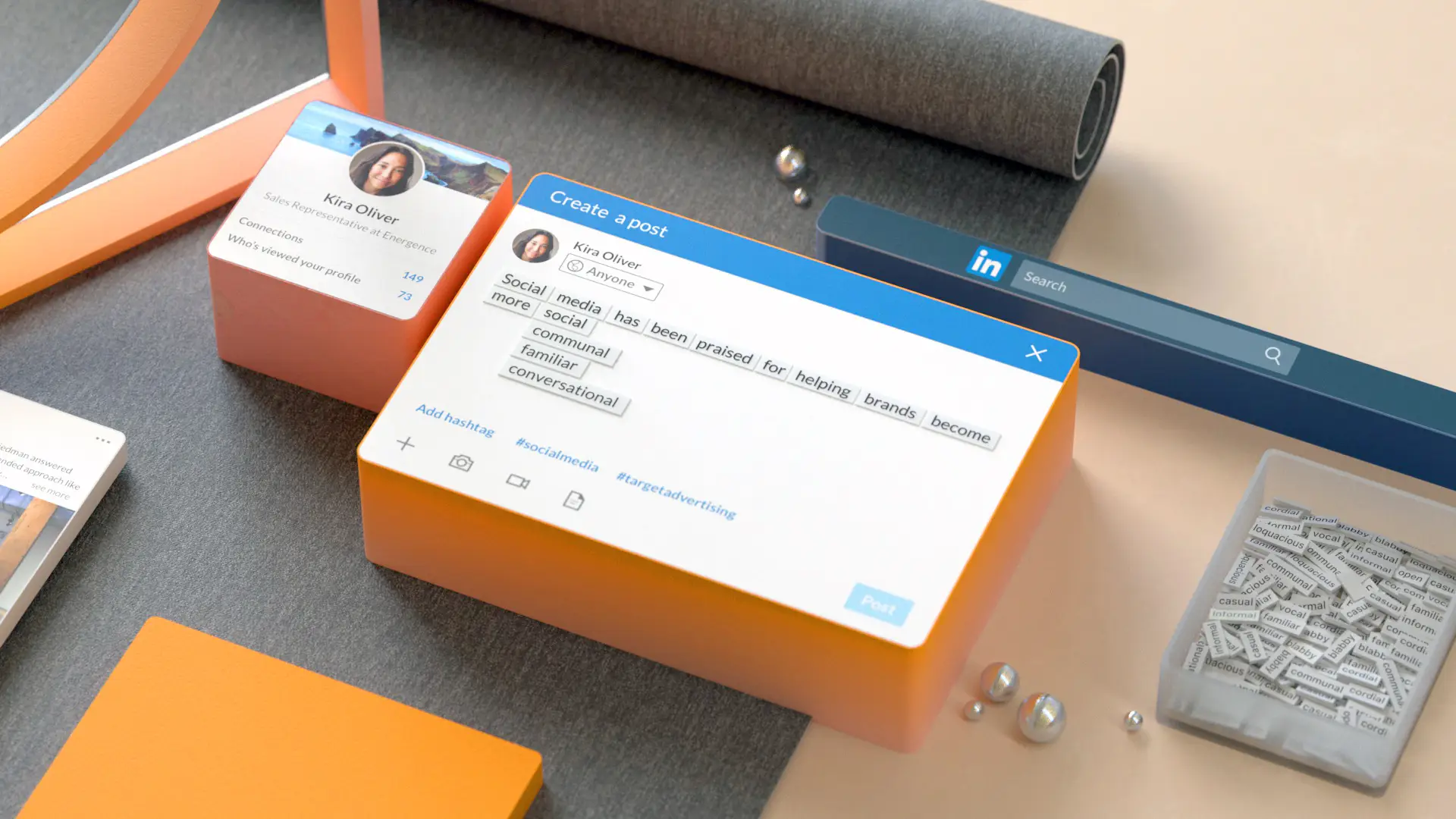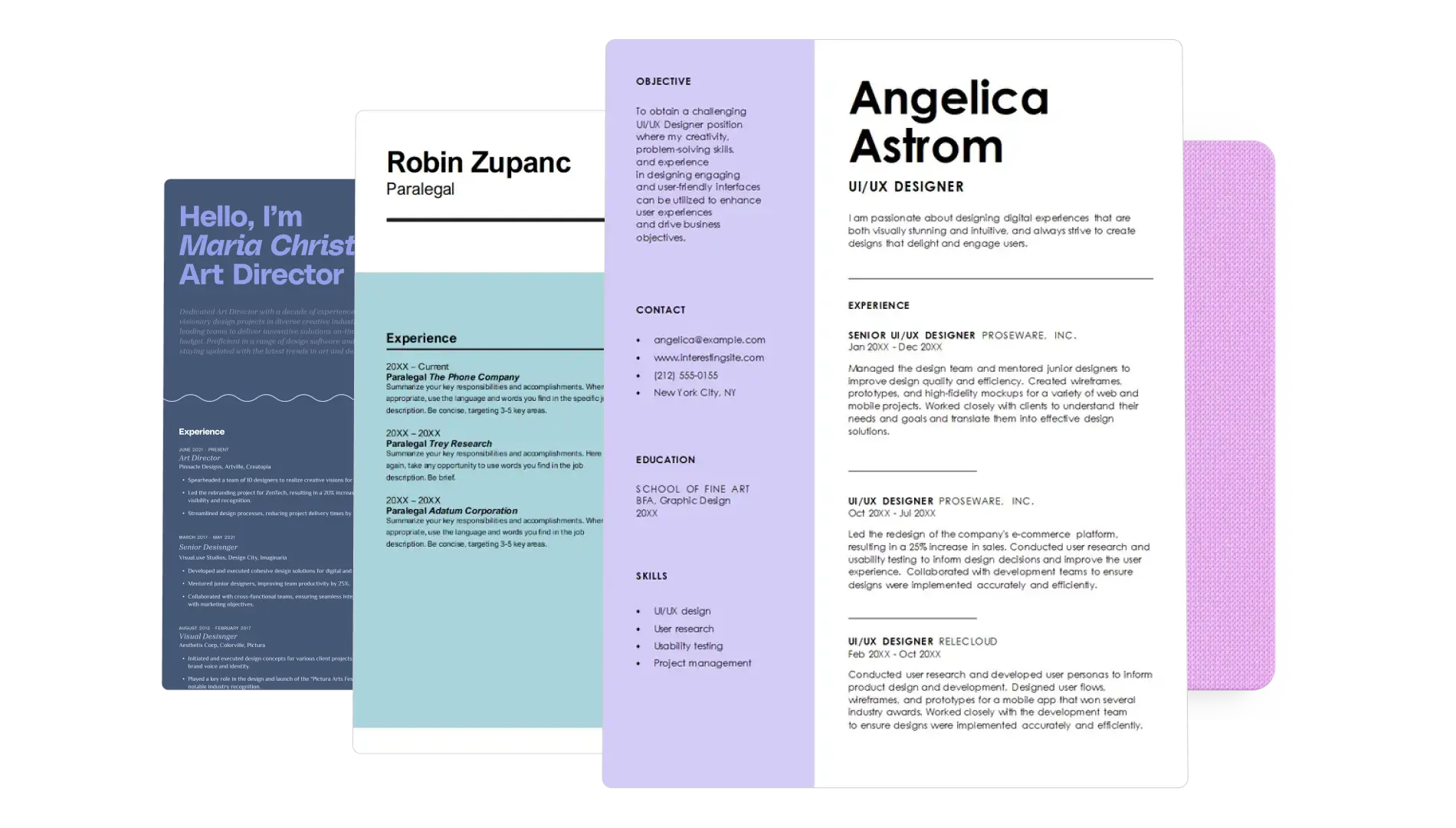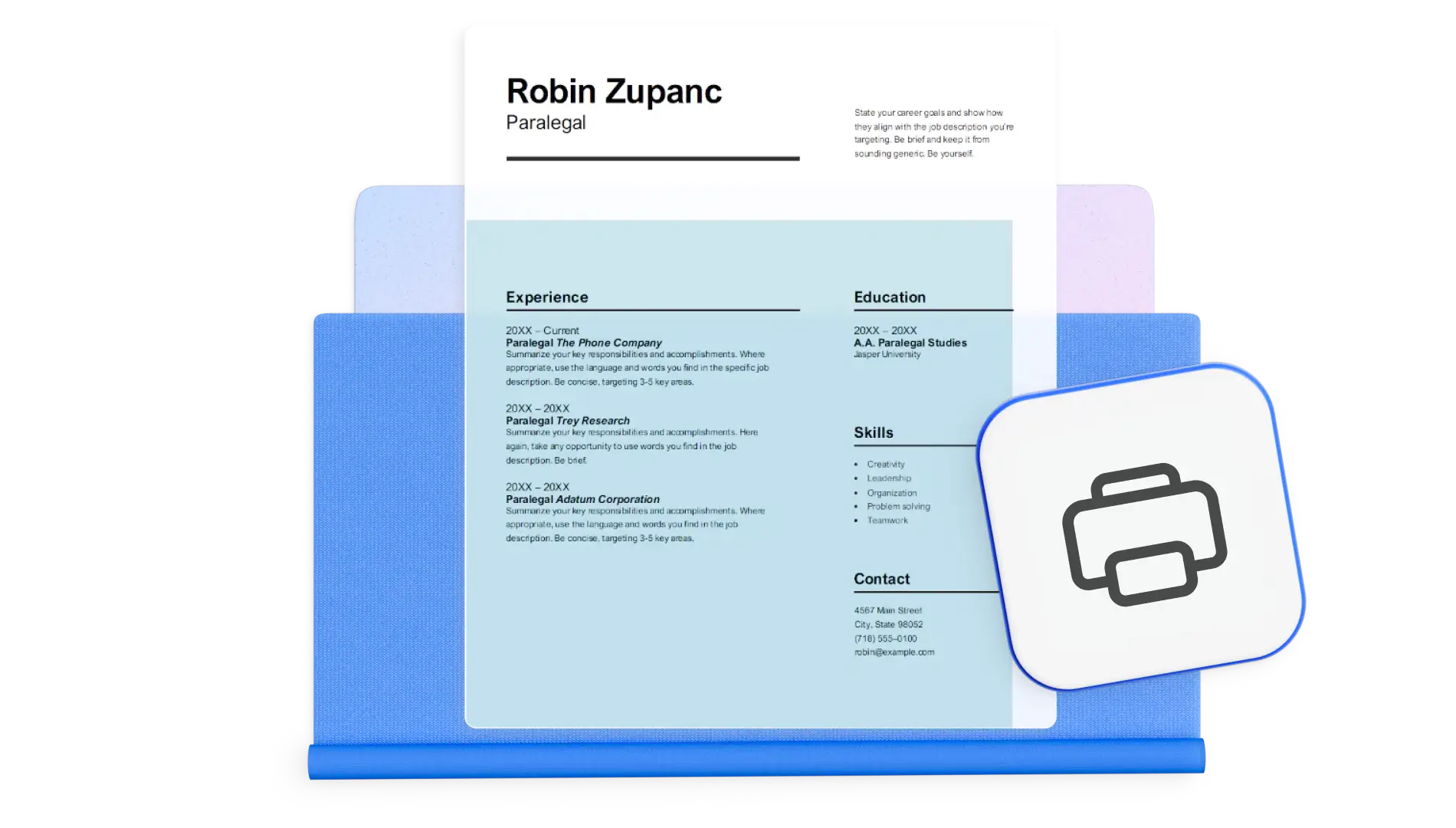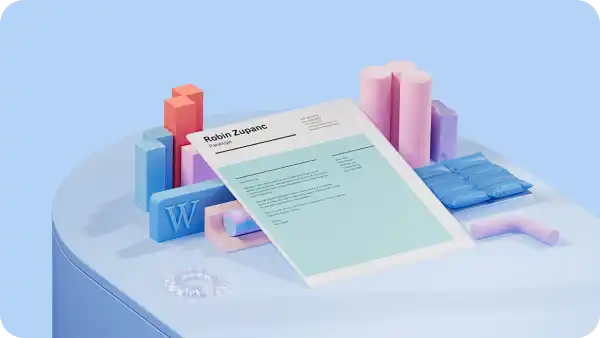On this page
Make your resume stand out from other job applicants by using the correct font and formatting. Your font choice can convey professionalism, but it’s not limited to just aesthetic benefits in 2025. The right font can also make your resume pass the Applicant Tracking System (ATS) software and have a greater chance of reaching the hiring manager.
Discover experience-led tips on font styles, sizes, and other resume formatting best practices to apply and align yourself with your desired job role. Use the Word resume builder and make your resume easy to scan by hiring managers and recruiters.
The 5 best resume fonts
What’s the best resume font and size? Well, it’s not “Times New Roman size 12”, at least not if you want to make a lasting impression in 2025. With only seven seconds spent on every resume, it's important to stand out and leave a lasting professional impression.
Your resume font choice can convey your credibility and personality as there’s a psychology associated with how fonts make us feel. That’s why it’s important to find a font that represents you and supports you in creating a positive first impression. Let’s explore the top ATS-friendly resume fonts recommended by experts at Microsoft Word.
1. Calibri
A modern sans serif font, Calibri, has become the corporate gold standard. Simple to read, it exudes professionalism and authority. With bold and light styles, it’s easily adaptable to make the impression you want. It’s a great fit for careers like law, finance and healthcare, or any job where simple professionalism is valued highly.
See it in action in this ATS stylish accounting resume example.
2. Montserrat
Display approachability with this interesting urban font in your resume. Montserrat is a go-to typeface for print advertising and urban street signs, so it’s a natural fit for resumes in creative fields, wellness, and real estate. This font without serifs has a bold feel while being extremely clear and scannable.
See it in action in this classic UX UI designer resume example.
3. Candara
If you’re looking for a subtly stylish font, Candara is a great choice. This font looks interesting while being easy to read, so it’s a good fit for resumes that are less text heavy like a combination resume format. We suggest using this font for internship resumes, software, and IT role resumes.
See it in action in this modern web developer resume example.
4. Cambria
Give out a reliable vibe with Cambria, a traditional and balanced serif font. It's designed for easy on-screen reading in small text sizes and is definitely an ATS-friendly font. It’s professional and can be applied to any of your resume needs. It suits roles like management, human resources, and leadership. It can also be used for engineering and architecture resumes as it supports math and science symbols.
See it in action in this restaurant manager resume template.
5. Aptos
The current default Microsoft font is a sleek sans serif font which has a neutral personality, which makes it a good choice for any profession you work in. This ATS-friendly font is easily customizable with style variants of headings and body. It's versatile but we especially recommend it for technology, healthcare, and management resumes.
See it in action in this simple ATS healthcare resume example.
How to pick the right resume font for your needs
Now that you know some fonts that are ATS-friendly and easy to scan, understand how you can find the right font for your job application needs. Choosing the right font for your resume based on the job role and seniority level involves understanding the cultural and professional nuances of each sector, as well as the impression you want to make on your potential employers. Here are some guidelines to help you find the best font for your use.
Consider the job role and level
Different job roles and seniority levels can influence how creative or formal your resume design and resume font should be. Choose your font by carefully considering the job you're applying for, based on if you’re applying for an entry-level, mid-level or senior position.
For example, Calibri could match a managerial job application, but another font like Montserrat might be able to convey more authority. Think about the impression you want to make.
Consider the field of work
Each profession and field of work comes with its own playbook of values and expectations. Resumes created for formal fields of work such as law, medicine, government and finance should convey reliability and professionalism, so fonts like Aptos and Calibri are a natural fit.
Evaluate existing experience
Your resume must highlight your relevant skills and experience clearly. The font you choose shouldn't distract from the content of your resume. If your resume is text-heavy, consider a simple font that can be easy to scan. If your resume is shorter or uses more bullet points than paragraphs, you could take more creative liberty.
Think about personal branding
A resume font is an opportunity to showcase your personality and stand out from other applicants. Much like a tie, it can be used to communicate about one’s style in the context of the workplace—search for one that aligns with yours.
Recommended resume font sizes
Change the font size in your resume to help draw the recruiter’s eye to the most important skills and achievements you have on offer. Always prioritize readability and follow these general guidelines if you’re creating a resume from scratch:
Name font size: use a large font size like 36 points to spotlight your name. While this will depend on your resume’s overall design, you need to ensure it stands out right away.
Paragraph headings font size: use 11 points in bold styling to make sure your resume headings make an impact.
Headings font size: use 10 points in body styling to ensure clarity.
Bullet points: use 8 points to list any skills, achievements, certificates or nice-to-have information. Unsure what to write in your bullet points? Explore our guide on how to write a resume quickly with AI.
Out of time, or want to make your resume creation simpler? Get started with an ATS-friendly resume template on Word.
If you want to continue with a custom resume, read our tips to ensure it is ATS readable.
ATS-friendly resume formatting tips
Optimize your resume to be easily screened and selected by the ATS which reads content from left-to-right. You can get closer to accepting your next role if you keep these resume formatting tips top of mind:
Resume formatting do’s
Use heading styles to highlight section titles.
Use standard capitalization (rather than lowercase or all caps).
Use standard line spacing of 1 point.
Use 1-2 font colors like black and grey or black and navy for improved accessibility.
Use normal margins (1”) instead of narrow margin settings (0.5”) for readability.
Resume formatting don’ts
Don’t use italics styling for any important information.
Don’t underline resume text.
Don’t create tables as ATS can’t interpret visuals logically.
Don’t use icons or graphics to indicate skills—simply use text.
Don’t use more than 2 fonts to maintain readability.
Next steps in your job search
Craft your cover letter
Pair your resume with a tailored cover letter addressed to the recruiter or hiring manager to help you stand out from other applicants and express your professional edge. Learn how to write a cover letter in a few easy steps.
Update LinkedIn to match resume
Level up your LinkedIn profile to reflect your resume, latest skills, and job aspirations. Hiring managers often verify credentials and social presence, so audit and improve your profile before you apply for your next job. Ensure your profile is up-to-date with a professional photo, a compelling headline, and a focused professional summary.
Ready to draft your resume with the right font? Speed up your resume creation by choosing an editable, professional resume template in Word. Get started with the resume builder.
Frequently asked questions
What font should you not use on a resume?
Fonts like Comic Sans and other over-stylized fonts may be viewed as too decorative and unprofessional. Avoid such fonts as they are not easy-to-scan by the ATS scanners either, reducing your chances of reaching a recruiter.
Are serif fonts or sans serif fonts good for resumes?
This depends on your profession and personal preferences. Sans serif fonts have a clear and modern look (think Calibri and Arial) while Serif fonts have a classy but traditional look (think Garamond and Times New Roman. It’s good to note that the additional strokes in some decorative Serif fonts can also make it harder for the ATS software to scan your resume, so it’s good to stick to easy-to-read fonts.
